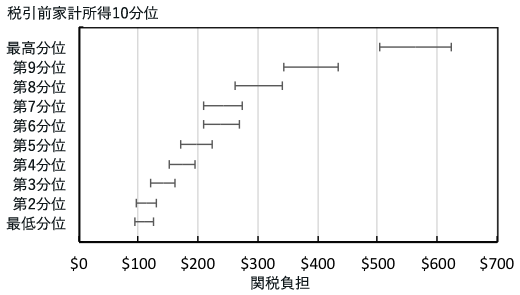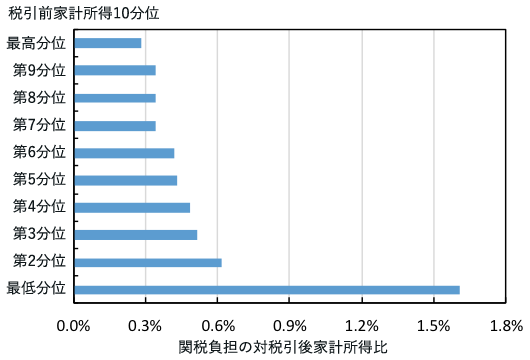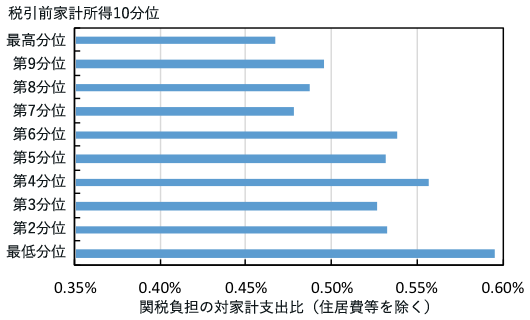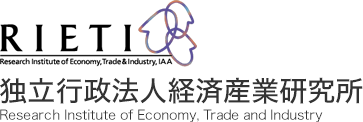関税(輸入品に対する税)は、所得の低い世帯により大きな負担を強いているようだ。低所得世帯は一般的に家計の支出や所得の割に輸入品に費やす金額が高く、一部の主要消費財に比較的高い関税が課されているためである。本稿では、貿易と個人消費に関する精細なデータを突き合わせて構築した新たなデータセットを用いて、所得層別、家族構成別の関税負担を推計する。分析結果は、関税が女性と1人親世帯に最も重い負担を強いる逆進税となっていることを示唆している。
米国の関税徴収額(輸入品に課される税の徴収額)は年間330億ドル超に上る。これはGDP(国内総生産)の約0.2%に相当する額である。保護貿易推進派が共通して主張するのは、関税を引き上げ、多くの人々がほんの少しずつ追加コストを負担することで、特定産業に集中する多くの就労人口が守られるというものである。ここで見過ごされているのは、他の租税と同じように、関税はすべての商品に均一に課されるわけではなく、特定の商品とその購入者により大きな負担を強いるという事実である。消費の観点から見ると、所得が低いほど食品や衣料品のような貿易財への支出割合が高く、結果的に、低・中所得世帯は、高所得世帯に比べて、相対的に大きな貿易の恩恵を受けていることが先行研究で明らかになっている(Fajgelbaum and Khandelwal 2016)。さらに、関税そのものに逆進性があることを実証しようとする試みもなされている(Gresser 2002, Moran 2014)。しかし、関税そのものの効果に関する包括的な研究はまだ報告されていない。私たちは、より詳細に実態を把握し、所得や住居費以外の支出に占める割合で見た関税負担が低・中所得層で実際に高くなっていることを示す証拠を見つけるため、輸入関税と標準的な個人消費に関するデータを突き合わせた。その結果、関税は米国の消費者にとって逆進課税となっており、製品によって税率が異なり、歪みが生じていることが示された。
逆進税としての関税負担
関税の世帯間所得分配効果を推計するため、私たちは、米国商務省国際貿易局(ITA)の通商政策情報システム(TPIS)データベースから得られる情報に基づく税関・国境警備局の関税徴収額と同労働省労働統計局の2014年消費者支出調査(CEX)における商品分類を突き合わせることで、新たなデータセットを構築した。このデータセットでは、全部で381の消費分類と各分類に対応する関税データの突き合わせを行った。HSコードとCEX上の商品分類を突き合わせ、消費分類毎に関税徴収額を輸入額で除して平均実行関税率を算出した(注1)。この計算では、中間投入財経由でもたらされる関税の影響は考慮せず、輸入消費財に対する関税のみを対象とする。消費分類別に集計されたデータセットは米国労働省統計局のウェブサイト(注2)で公開されている。データセットの構築と解釈については付録に詳述する。
関税で保護されても国内製造業者による類似商品の価格引き上げはないと仮定し、米国の消費者の関税負担について保守的な推計を行ったところ、所得分布で下位10〜20%に属する最貧困層の関税負担は世帯あたり年間約95ドル、中所得層は約190ドル、上位10%に属する最富裕層は約500ドルという結果が得られた。下図は、国内製品の価格への影響を反映させた場合も含め、想定される関税負担の範囲を示している(詳細は付録・注6参照)。

しかし、所得対比で見ると、関税負担は最富裕層より貧困世帯のほうがはるかに大きい。次に示す2つの図は、所得10分位別の関税負担を税引後所得対比と住居費以外の支出対比で示したもので、関税の逆進性が明確に見て取れる。CEXについては、周知のとおり、超低所得層の消費・所得比率に関するデータの質に問題がある。したがって、最低分位(第1分位)の関税負担の対税引後所得比については慎重な解釈を要するが、それでもなお、全般的な逆進性のパターンは明らかである。


上記は、関税による直接的な負担を保守的に推計したものであるが、最近さかんに議論されている他の税制措置の効果に比べて大きな数値となっている。2001年と2003年の減税措置は、所得分布で下位20%に属する貧困世帯の税負担を年額28〜87ドル削減する効果があったと推定されるが、関税をなくせば、はるかに大きな効果をもたらすことができる。関税率が全体的に10ポイント引き上げられていたらどうなっていただろうか。引き上げ分が全額消費者に転嫁される一方、国内価格への追加的な影響はなかったと想定すると、各所得層の世帯が2014年に消費した商品群のコスト(為替レートを含め他の条件はすべて同じ)は、所得水準が低い第1分位と第2分位では301ドルと307ドル、第5分位と第6分位では611ドルと716ドル、最も所得水準の高い第10分位では1462ドル、それぞれ押し上げられていただろう。
関税は消費者に恣意的で意図せざる結果をもたらす
経済学者は、あたかも関税が経済全般に均一に適用されるものか、さもなければ最も保護に値する業種や脆弱な業種に限り保護するためのものであるかのように、型にはめて考える場合が多い。しかし、実際には、慎重に対象を絞り込んだ結果として、必ずしも明確でない理由で特定の集団や製品が優遇されている場合もあり、細分類レベルのデータで見ると関税は実に多様である。たとえば、新学期に向けた買い物をしている家族を考えてみよう。合繊のリュックサックには17.6%、ボールペンは1本につき0.8セントの従量税と5.4%の従価税、鉛筆とクレヨンは約4.3%、マーカーは4%、シャープペンシルは6.6%の関税が課されている。このように、米国の関税法では、マーカーよりボールペンやシャープペンシルを使うほうが、学生の負担は大きくなる。一方、クロスカントリースキーやサーフィンボード、アーチェリー装備の輸入には関税がかからない(USITC 2016: Chapters 42, 95)。
消費財のうち、衣料品、各種家財道具、その他の家庭用品などでは、安い品目により高い税率の関税がかかっている場合があり、私たちが算出したベンチマーク推計値が示す以上に逆進性が高くなっている。米国の細分類レベルの輸入データを見ると、多くの品目分類で単価(価格の代替指標)と法定関税率の間に強い負の相関関係が認められる。これは、低価格商品のほうが高価格商品より高い関税率がかけられている場合があることを示している。品目分類はHS4桁分類、相関係数はHS 8桁分類レベルで算出した。国連統計で消費財に分類されるHS4桁分類品目については関税と価格の相関係数が算出されているが、関税率の高い商品の価格は低い商品の価格のおよそ半分となっており、強い負の相関関係は日常生活で用いられるさまざまな商品で認められる。たとえば、成人、子ども、幼児の衣料品、防水靴、家財道具・寝具、オリーブオイル、加工トマト、ワイン、自転車、キャンプ道具、ヘルメット・スポーツ用保護ヘッドギア、小型調理家電、加湿器、時計、食器・台所用品、宝石箱を含む木工箱などである。
ときに関税率の差は人為的な所産、つまり、何十年もの交渉の積み重ねによって生じた遺産のように見える。バッグ、スーツケース、その他の入れ物は、用途と素材によって、ゼロから20%までまったく異なる関税率が適用される(USITC 2016: Chapter 42)。スポーツ用グローブは素材に関係なく、どのスポーツで使うものか、場合によってはどのポジションで使うものかによって、関税率がゼロから6%近くまで異なる。アイスホッケー用グローブはゼロ関税なのに対して、スキー用グローブは最高で6%近く、ゴルフ用グローブは4.9%の関税がかかる。野球用・ソフトボール用のグローブは、バッティング用のみ3%の関税がかかり、それ以外はかからない(USITC 2016: Chapters 42, 61, and 62)。紙パルプ製もしくはセルロース製のおむつは、ウルグアイ・ラウンドでのパルプ・紙製品のセクター合意によりゼロ関税となっているが、綿布その他の繊維でできたおむつは2.8%〜16%の関税を課せられる可能性がある(USITC 2016: Chapter 96)。この種の歪みが貿易と厚生に及ぼす影響や全体的な貿易制限度との関係の計量化については、たとえば、Anderson and Neary(1996 and2007)、Kee et al.(2009)、Kee et al.(2013)がさまざまな方法を論じている。
関税は1人親世帯に重く、男性向け商品より女性向け商品に高い税率がかけられている
属性別に見ると、関税負担は子どものいる世帯、特に1人親世帯で高くなっている。
| 世帯の属性 | 関税負担 (対所得比) |
関税負担 (対所得比、住居費除く) |
|---|---|---|
| 夫婦(子供なし) | 0.34% | 0.44% |
| 夫婦(子供あり) | 0.37% | 0.53% |
| 独身(子供なし) | 0.37% | 0.49% |
| 独身(子供あり) | 0.57% | 0.69% |
さらに、衣料品の平均実行関税率は、多くの品目で女性用が男性用を大きく上回っている。女性用衣類全般の実効関税率が23%であるのに対して男性用スーツは14%、セーター、シャツ、トップスは男性用13%に対して女性用21%、スポーツウェアは男性用7%に対して女性用21%、ズボンと半ズボン(ショーツ)は男性用10%に対して女性用15%、下着は男性用7%に対して女性用13%となっている。また、関税率表には「タンポン税」なるものがあり、紙やセルロース以外の素材(綿、合繊、人工繊維や織物)で作られた女性用衛生用品は3.6%〜16%の関税がかかる(USITC 2016: Chapter 96)。女性用衛生用品とおむつの両方を含むHS 9619の平均法定関税率(最恵国関税率)は7.6%である(WTO)。そのため、1人親世帯の中でも父親のみの世帯より母親のみの世帯のほうが、関税負担が重くなっている可能性がある。
結論
以上に示した初期的な分析に基づくと、関税は逆進課税になっているように見受けられ、低所得世帯ほど所得と住居費以外の消費に占める貿易財への支出割合が高いことだけでなく、各品目分類内における明白な逆進性も要因となっていると考えられる。本分析は、通商政策とその影響についてまだ検証されていない側面に光をあて、これに続く研究の切り口を提供するものである。この分野でのさらなる研究を歓迎するとともに、本分析のために作成した新たなデータセットがその一助となることを期待している。
謝辞:本分析と概要の作成に助力を得たLydia Cox、Conor Foley、Nataliya Langburd、Willie Powell、Nirupama Raoの各氏に感謝する。
付録
本分析を行うにあたり、私たちは、米国国際貿易委員会(USITC)の関税率表(Harmonized Tariff Schedule: HTS)から入手した詳細な関税データとCEXの消費データを統合して、新たなデータセットを構築した。関税品目分類と消費品目分類を突き合わせることで、世帯属性別の関税負担を算出できるようになった。消費品目分類別に集計したデータセットは研究者向けに公開されているほか、クロス集計に用いた詳細な未公表データも米労働省労働局に要請すれば入手できる。この新たなデータセットが他の研究者に活用され、さらに拡張・改善されていくことを期待する。
関税のデータはHSコードレベルで入手できるが、CEXより細かく分類されている場合が多い(たとえば、CEXで「魚貝類の缶詰」となっているのに対しHSは「加工された甲殻類、軟体動物およびその他の水生無脊椎動物」)。CEXの品目分類毎に、該当する支出品目の関税徴収額を輸入額で除することで平均関税率を算出した。これが実行関税率である。CEXは、四半期毎と年次で公表される詳細な家計支出調査である。消費品目分類は、「その他の機械設備」や「その他の生鮮果物」のように範囲が広いものも含まれているが、全般的に具体的で、たとえば、リネン製品は、風呂用、寝室用、台所・食堂用の区別がなされている(注3)。
一般的に、実行関税率は法定関税率の平均値、すなわち関税の真の経済的負担より低くなる。関税である商品の価格が割高になると、買い手は別の商品で代用しようとするからである。実行関税率を用いた場合、米国人が実際に購入した商品に課された関税だけを足し合わせ、関税がなければ購入していたかもしれない商品に課される関税は含まれないため、全世帯にかかる関税負担全体が構造的に過小評価される。たとえば、1000%という法外に高い関税を課された商品は、輸入が妨げられ、結果的に関税収入がゼロになるかもしれない。高関税が原因でほしい商品が手に入らない、あるいは、国内競合メーカーへの競争圧力が弱まり、価格が上昇するというかたちで消費者が受ける損失は、実行関税率には反映されない。
米国外で製造された商品を販売する企業は、販売価格を引き上げることで、輸入時に課された関税を消費者に転嫁することができる。外国企業は、関税後の価格競争力を維持するため、出荷時の利益率を下げることで関税負担を部分的に吸収するかもしれない。つまり、最終的な関税の影響は、生産者と買い手である米国の消費者の双方に及ぶということである(注4)。本研究では、簡素化のため、関税のコストは全額消費者が負担すると仮定したが、これは、Congressional Budget Office(2011)やCongress of the United States Joint Committee on Taxation, Fairness and Tax Policy(2015)の物品税の推計と同様の扱いである。実際、外国企業が関税の一部を負担しているとしても、関税負担の総額が上下するだけで関税の分配効果が変わるわけではないので、私たちの分析に影響を及ぼすものではない(注5)。
消費者は輸入品も国内製品も購入するため、関税率は、米国通商代表部(USTR)から入手したデータに基づき、主要製品分類における輸入品比率に相当する額に乗じることとした。国内で生産された製品は関税のかかる輸入品の代替物になるため、国内製品への価格効果を想定した幅広い分析も示した(注6)。

米国の関税収入は総額330億ドル超に上るが、うち250億ドルは国連分類の消費財に課される関税によるものである。家計支出(概ね消費財に分類される)に基づく私たちの推計で得られた関税負担額は270億ドル超である。関税収入総額との差は、照合しきれなかった品目があること、測定誤差、消費財からの直接徴収以外にも関税収入があることによる。特に私たちの分析においては、中間財への関税が国内消費財の価格を押し上げている可能性があるという事実が反映されていない。また、関税負担額の計算では輸入額にではなく国内支出額に実行関税率を乗じているため、小売段階での利益上乗せ分や売上税を含んでおり、関税収入に対して負担額が相対的に大きくなっている。しかし、実質的には、私たちが世帯属性別に割り振った関税負担額は消費財の関税収入総額にきわめて近く、直接負担額の妥当な代替指標と考えられる。
本稿は、2017年1月12日にwww.VoxEU.orgにて掲載されたものを、VoxEUの許可を得て、翻訳、転載したものです。




